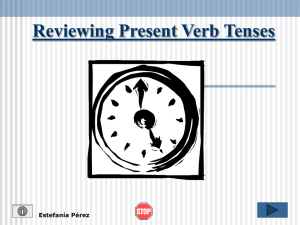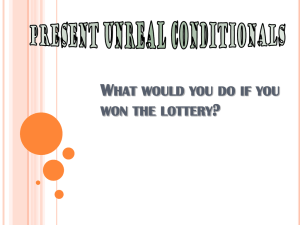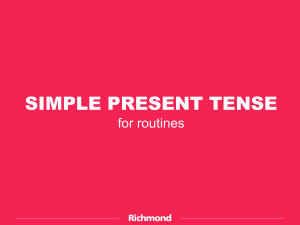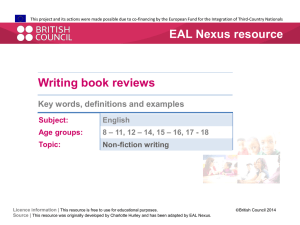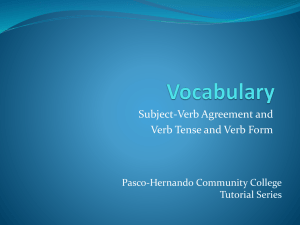Introduction to Thu Grammar
advertisement
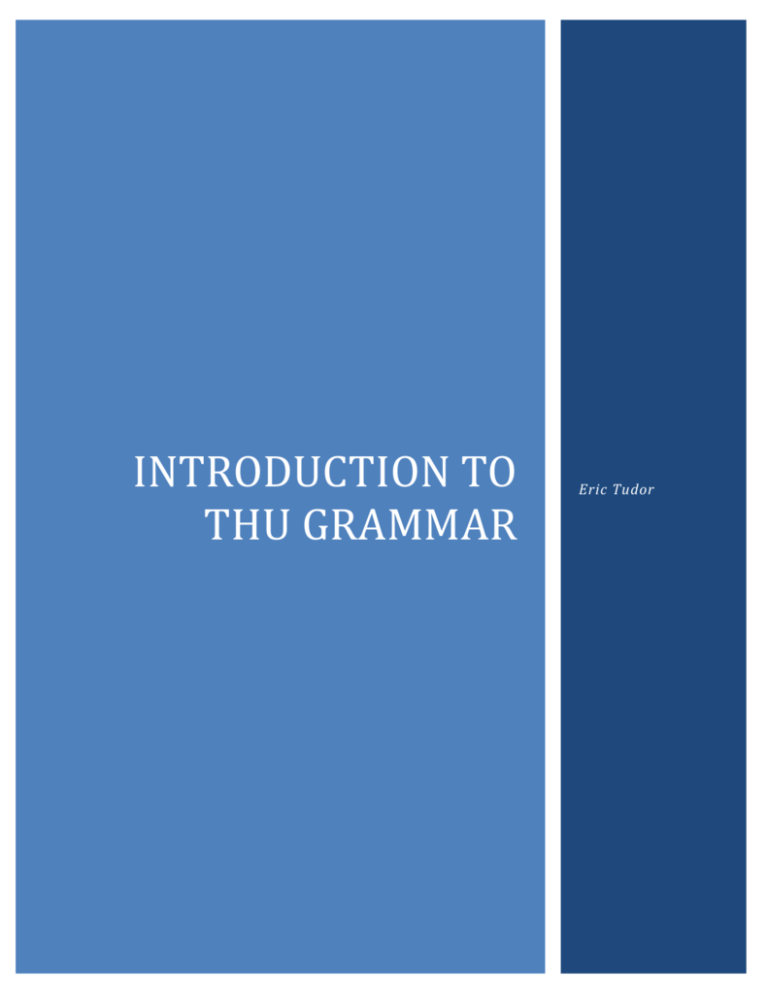
INTRODUCTION TO THU GRAMMAR Eric Tudor 1 Chapter 1: Sentence Structure Subject, Verb, and Object Languages can be categorized in grammar using the letters S (Subject), V (Verb), and O (Object). This determines the order of sentence parts in a sentence. Take for example this sentence: The dog ate the food. “Dog” is the subject (whom or what the sentence is about), “ate” is the verb (a word that represents an action), and “food” is the object (the receiving end of the verb). Therefore, the sentence pattern is SVO. This is the sentence pattern English follows. Thu, however, follows the pattern VOS. Here is an example of a sentence in Thu, translated literally into English: Ate food dog. The verb and direct object come before the subject in a regular Thu sentence. This pattern, however, is different in more complex sentences, but this will be mentioned more about later on. For now, just remember this structure when making a sentence. 2 Articles You may have noticed that in the second example on page 1, the word “the” was omitted. This is because there is no definite article in the Thu language. There are, however, indefinite articles. They are “tah” (singular), and “teh” (plural). “Teh” is used in Thu the same as “unos” or “unas” in Spanish. It can be translated as “some” or “a few”. Notice some examples of how the indefinite articles can be used. Tah men (an apple) Teh mene (some apples, a few apples) You can see the ways “tah” and “teh” are used. We will discuss more words and plurality later on. For now, here is a list of nouns and their plurals. Noun men chir caie vot vurbu chin chit matziva Plural mene chis caien vote vurbe chine chite matzive Meaning Apple(s) Key(s) House(s) Water(s) Dictionary(s) Pencil(s) Pen(s) Milk(s) Quick Note The word meaning “Thu” in Thu is “thub” (pronounced “thoob”). In English, words relating to Thu are Thuban, ex. Thuban language. Quick Note When referring to edible fluids in Thu (such as water or milk), the plural form is usually used. Singular form is only used when referring to a certain type. For example, you would say “I want some waters” rather than “I want water”, but you would still say “I want that water brand”. 3 Numbers & Plurality The following is a list of numbers up to 10. ITEM one two three four five six seven eight nine ten NEEDED uno iki uscie apat do liu ciu famania naiva dice To use these numbers, it is necessary to know plurals. There are four rules in making words plural. If the word ends in a consonant other than “r”, simply add an “e” to the end. If the word ends with “r”, change the “r” into an “s”. If the word ends with a vowel other than “e”, change the vowel to an “e”. Finally, if the word ends with “e”, simply add an “n” to the end. “Chit” changes to “chite”. “Chir” changes to “chis”. “Matziva” changes to “matzive”. “Caie” changes to “caien”. Unlike in English, when indicating that there is zero amount of something, the singular form of the word is still used. 4 Verb Conjugation In this lesson, we will talk about verb conjugation. Verb conjugation is changing the verb to fit whoever or whatever is doing the action. A verb that is not conjugated is known as an infinitive. The best example of in English is the infinitive “to be”. The first person singular form is “am”, the second person singular and plural, third person plural, and first person plural form is “are”, and the third person singular form is “is”. This conjugation is illustrated by the chart below. First Person Second Person Third Person Singular am are is Plural are are are To conjugate verbs in Thu, first take the infinitive. All infinitives in Thu end with the letter “e”. Change the infinitive according to the following table. First Person Second Person Third Person Singular change “e” to “u” change “e” to “a” change “e” to “at” Plural change “e” to “um” change “e” to “am” change “e” to “ata” For an example, take the infinitive “gine”, which means “to run”. Again, a chart demonstrates the rule. First Person Second Person Third Person Singular ginu gina ginat The next lesson will talk about pronoun usage. Plural ginum ginam ginata 5 Pronouns and Forms of “To Be” Pronouns are words that replace nouns and are essential to avoid being redundant. Words like “he”, “she”, “I”, and “we” are all pronouns. There are also two types of pronouns: subject and object. Subject pronouns represent the subject of the sentence, in other words, who or what is doing the action. Object pronouns receive the action. Here is a chart of subject pronouns. First Person Second Person Third Person Singular mi (I) ad (you) li (he), si (she), ha (it) Plural ciu (we) ade (you [plural] ) le (male), se (female), he (they) This is the chart of object pronouns. Singular mid aded lid (him), sid (her), had (it) Plural First Person ciud (us) Second Person adede (you [plural] ) Third Person led (male), sed (female), hed (them) There is one more verb needed for using these pronouns: to be. The infinitive is sere. Here is the conjugation. First Person Second Person Third Person Singular seru sera serat Plural serum seram serata Remember the order of words in Thu. The verb and object come before the subject. Therefore, to say he is a boy, you would say: Serat tah bino (boy) lid. We have covered all the basics for communicating in Thu. The next chapter will elaborate on more complicated sentences, including words such as “because” and “as”. 6 Chapter 2: Separate Clauses and Special Word Usage Questions So far, we have covered simple declarative sentences. We can say simple things that people and objects are doing. This section will cover forming questions. First, you must know some question words. Here is a list of the “Five W’s”: who, what, where, when, and why. Word siuto cato gido kada etansiuto Definition what who where when why The other thing that is important is placement of the question word. The word is almost always placed at the end of the sentence in simple questions. To form interrogative sentences, first form a declarative sentence about what you are questioning. Then, add a comma at the end of the sentence and add the interrogative word, followed by a question mark. Ginu ad. (You run) Ginu ad, etansiuto? (Why do you run?) Of course, to answer a question such as this one, you need to know the word “because”. In Thu, it is “kunki”. However, using this word requires knowledge of verb usage that will be covered later in the chapter. For now, just familiarize yourself with the question words and forming questions. Quick Note In English, you would normally say “why are you running” as opposed to “why do you run”. In English, the form of verbs using “ing” is known as the progressive tense. The progressive tense is not used as often in Thu, meaning “why do you run” is a more typical question to ask. 7 Adjacent Infinitives This section may be unfamiliar to you at first, as this section covers a rule that does not exist in English. It is grammatically incorrect to have two conjugated infinitives directly next to each other. One way of illustrating this rule is with the infinitive “piaghe”, which means “to like”. It is conjugated just like any other verb. “Piagho mene” means “I like apples”. One thing to notice in this sentence in Thu specifically is the lack of a stated subject. Because verbs in Thu are conjugated for every subject, directly stating one is not needed in the present tense. The future and past tenses will be discussed in Chapter 3. However, you can also use “piaghe” to state your like of doing actions. This is where the adjacent infinitive rule comes in to play. Let’s say you like to run. Saying… Piagho ginu …is incorrect. Instead, the word “gine” should be left in its infinitive form. Piagho gine. …is correct. However, sometimes you will need to use the preposition “ga”, which means “to”. If the infinitive will be followed directly by the conjugated verb, “ga” is not needed, unless the infinitive gives a reason for the prior action. In most other cases, though, “ga” should be used. Ginu ga sere santo (healthy). …is an example of when “ga” should be used, because “to be healthy (sere santo)” gives a reason for running. 8 Prepositions & Travel Sometimes, you will need to talk about travelling. The infinitive for “to go” in Thu is “ciufe”. It is conjugated just like any other verb in Thu. However, in order to use this verb, we will need to know some prepositions, or words that describe location. Word ga zai siung har faoi olter sopar aroo Definition to in on across under over above around “Ciufu ga cafe (café)” means “I go to the café”. “Ciufum aroo kopek (dog)” means “We go around the dog”. This verb ties in with the rule of adjacent infinitives. If you want to say that you are going to do something and want to express physically going somewhere, you can use the form “ciufe ga (inf.)”. Simply conjugate “ciufe”, add “ga”, and then add the infinitive for what you are going to do. You may be surprised at how often you use this verb. It is very important to practice this as much as possible. Quick Note The word “kopek”, meaning “dog”, can also be used as a verb with the infinitive “kopeke”. It can mean “to annoy” and often is used when someone irritates you. 9 Chapter 3: Past, Present, and Future Simple Future Tense In regular speech, we use the future tense more often then we realize it. It is essential to know this form in Thu. To speak in the future tense, first take the infinitive of the verb and change it according to the following chart. First Person Second Person Third Person Singular add “ru” to end add “ra” to end add “rat” to end Plural add “rum” to end add “ram” to end add “rata” to end. “Sereru” means “I will be”. “Ginerata” means “They will run”. In English, when we talk about the future and what we will do, we often say we are going to do something. One way of expressing this in Thu is by using the term “za (inf.) sere (conj.). To use this form, simply conjugate sere and add “za” and the infinitive before. “Seru za gine” means “I am going to run”. “Seru za sere” means “I am going to be”. Alternatively, you could use a form of “to go” followed by the preposition “to” and then the infinitive as a more literal translation. 10 Simple Past Tense We also use the past tense of verbs a significant amount of the time in speaking. It is just as important to know how to use the past tense in Thu. Just like how in English we use the word “will” for speaking in the future tense, in Thu you can use the word “avua” to talk in the past tense. Just like in any other Thu conjugation, first take the infinitive. However, instead of changing the infinitive in six different ways, simply add a “ka” to the end of the word. Then, add the word “avua” before. “Avua gineka mi” means “I ran”. “Avua sereka tah bino li” means “He was a boy”. Sometimes in speaking we use the word “just to describe what has recently happened. In Thu, you can use the word “doar” just after the word “avua”. “Avua doar gineka ciu” means “We just ran”. “Avua doar sereka tah bino li” means “He was just a boy”. Unlike in the present and future tenses, the subject needs to be directly stated in the past tense to clarify. There are many different uses for the past and future tenses. However, there are still more forms to learn about the verb tenses. The next few chapters will talk about the perfect tenses of verbs. 11 Future Perfect Tense The future tense is not one that is used often in everyday speech, but is still important to know. In English, the future perfect tense is stating what will have happened. The following are all examples of the perfect future tense. I will have built this birdhouse by tomorrow. They will have eaten the cake by three o’clock. The future perfect tense in Thu is very similar to the regular past tense. To use the future perfect tense, first take the regular past tense. Then, simply change the word “avua” to “avuara”. No other change in verb tense is necessary; doing so would be grammatically incorrect. “Avuara gineka si” means “She will have run”. “Avuara sereka he” means “They will have been”. Granted, it may seem as if you won’t this verb form much. However, you might be surprised how many situations could come up involving the future perfect tense.


